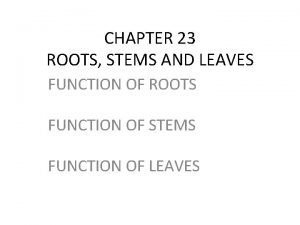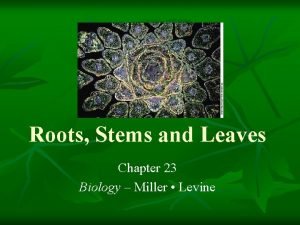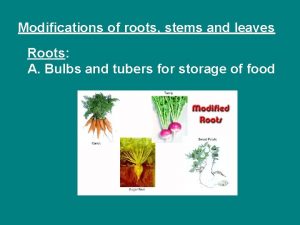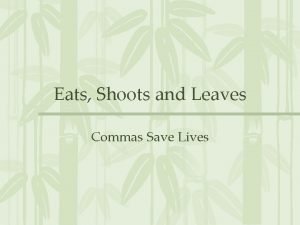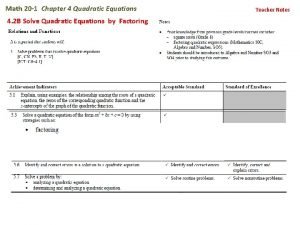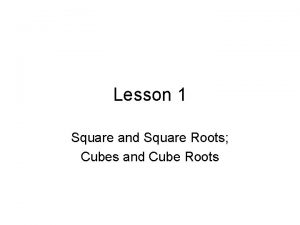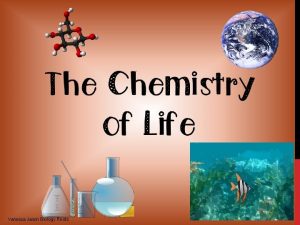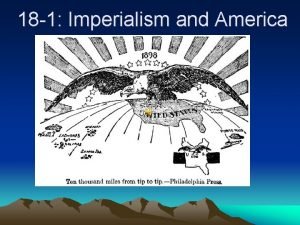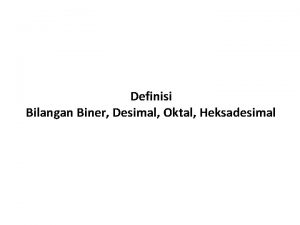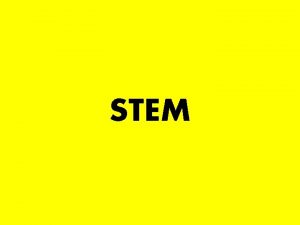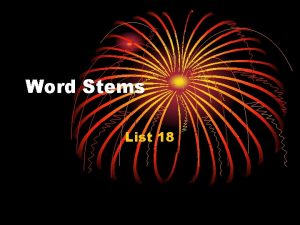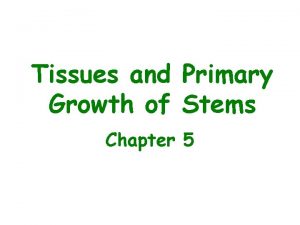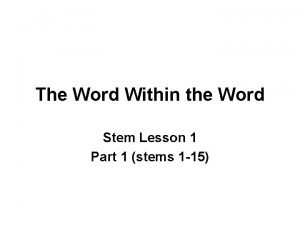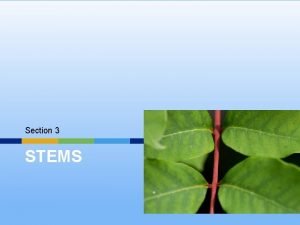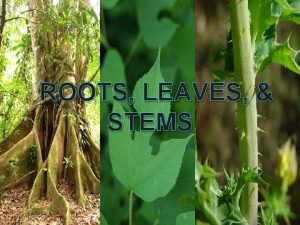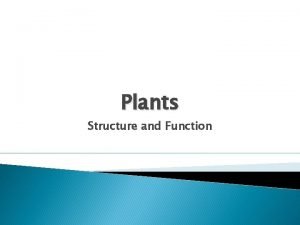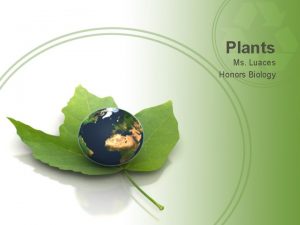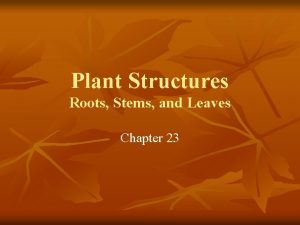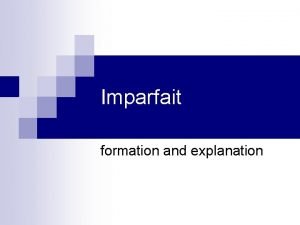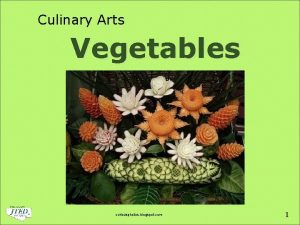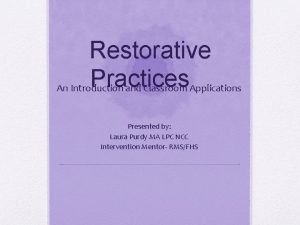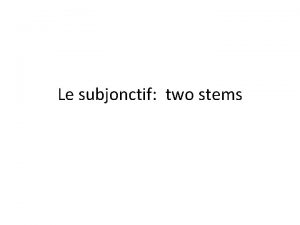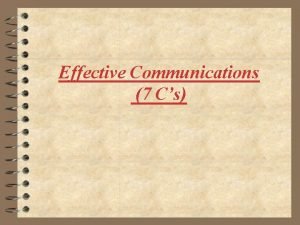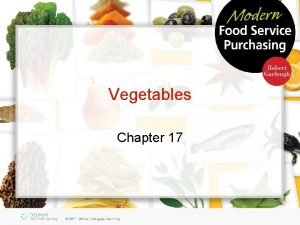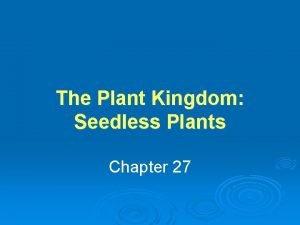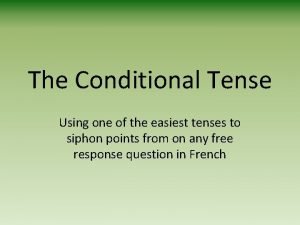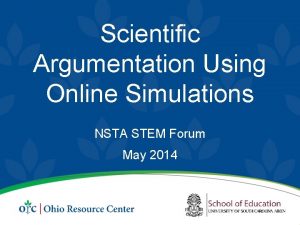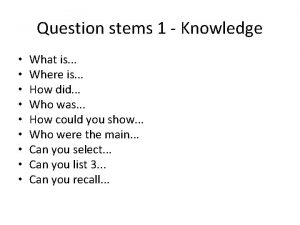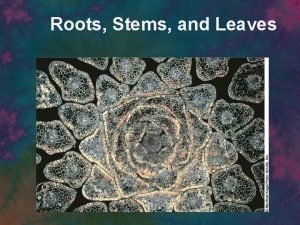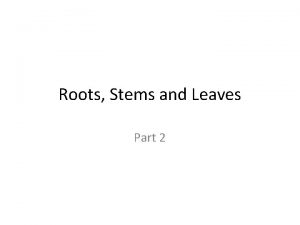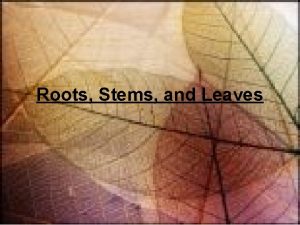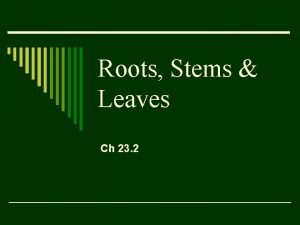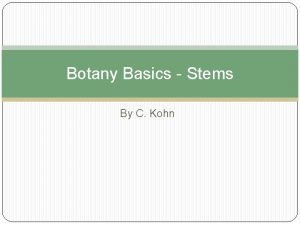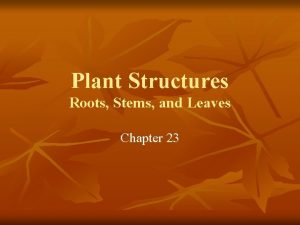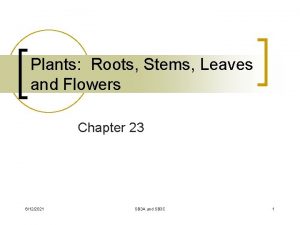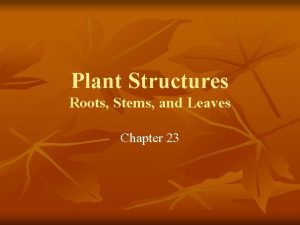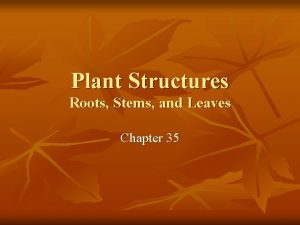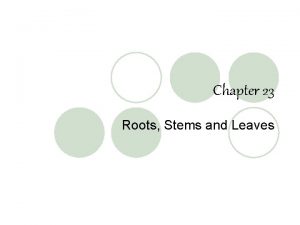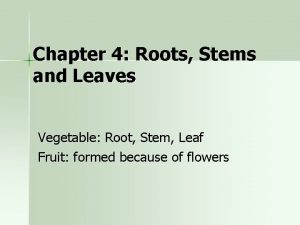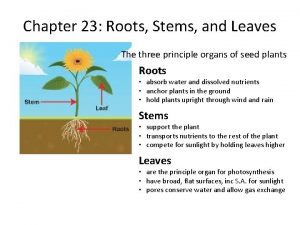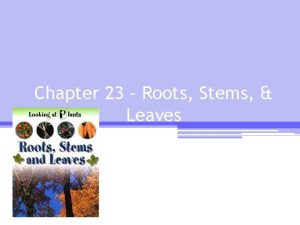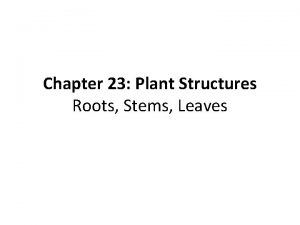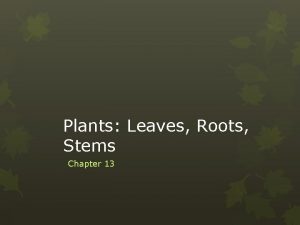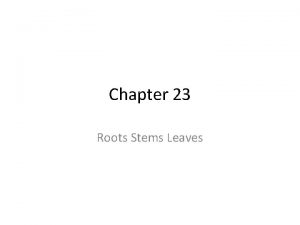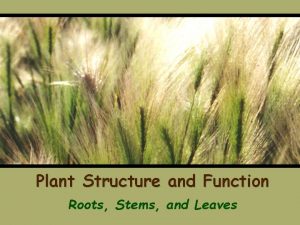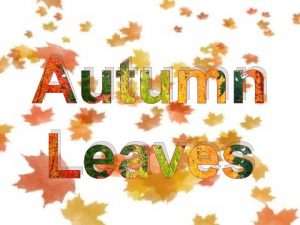Roots Stems and Leaves Chapter 23 p 578















































- Slides: 47

Roots, Stems and Leaves Chapter 23 p. 578

Structure of Seed Plants • The cells of seed plants are organized into different tissues and organs. • The three principal organs of seed plants are: –Roots –Stems –Leaves

Roots • Absorb water and dissolved nutrients from moist soil. • Anchor Plants in the ground • Hold plants upright and prevents them from being knocked over by wind and rain. • They grow and develop complex branching networks that penetrate the soil and grow between soil particles.

Stems • Supports the plant body. • Transports nutrients among different parts of the plant. • Hold leaves up to the sun. • To support the weight of tall plants, stems have modified vascular tissue. • Provides the passageway for xylem and phloem to transport water and nutrients throughout the plant.

Leaves • Principle organs for photosynthesis. • Broad, flat surfaces help increase the amount of sunlight absorbed by plants. • Stomata are adjustable pores that help conserve water while allowing oxygen and carbon dioxide to enter and leave the leaf.

Types of Plant Tissues • Plants have specialized tissue systems. • Plants consist of four tissue systems: – Meristematic Tissue – Dermal Tissue – Vascular Tissue – Ground Tissue

Meristematic Tissue • Found ONLY in the tips of shoots and roots. • The ONLY plant tissue that produces new cells by mitosis. • Site of rapid cell division. • The Apical Meristem is a group of undifferentiated cells that divide to produce increased length of stems and roots.

Lateral Meristems • Lateral Meristem: cylinders of dividing cells along the length of roots and stems and are responsible for secondary growth (increase in width/girth).

Dermal Tissue • The outer covering of a plants. • Typically consists of a single layer of Epidermal Cells. • Cuticle – thick, waxy layer that protects against water loss and injury. • Some have Trichomes – protect the leaf from water loss or secrete toxic substances and make it look fuzzy. • Also includes root hairs, guard cells, and stomata.

Vascular Tissue • Transport water and nutrients throughout the plant. • Consists of two major types: – Xylem – Phloem

Xylem • Made of Tracheids – long, narrow cells with walls that are impermeable to water. • Angiosperms have a xylem called a Vessel Element. – Much wider than tracheids and allow for greater movement.

Phloem • The main phloem cells are Sieve Tube Elements. – Are arranged end to form sieve tubes. • Materials can move through holes in the tubes from one adjacent cell to another. • Companion Cells are phloem cells that surround sieve tube elements. • Support the phloem cells and aid in the movement of substances in and out of the phloem stream.

Ground Tissue contains 3 Main Plant cell types: • The cells that lie between dermal and vascular tissue. • Parenchyma – thin cell wall and large central vacuoles, site of most photosynthesis. • Collenchyma – Strong, flexible cell walls, used for support (thick ridges in celery). • Sclerenchyma – Extremely thick, rigid cell walls, make ground tissue tough and strong.

Dermal Tissue

Tissue Systems

Review Questions… • 1. List the three tissue systems of plants. • 2. Describe how each tissue is distributed in stems, tissues and leaves. • 3. What is the function of meristematic tissue? • 4. What two cell types make up the xylem? • 5. What two cell types make up the phloem? • 6. In a stem that needs to support heave leaves, what type of ground tissue might you expect to find? • 7. The vascular system of a plant has been compared to the circulatory system of a human. How are they similar? Different?

Types of Roots • The two main types of roots are Taproots and Fibrous Roots. • Taproots are found mainly in dicots. – Have a central primary root and generally grow deep into the soil. • Fibrous Roots are found mainly in monocots. – Branch to such an extent that no single root grows larger than the rest. – Typically help topsoil from being washed away.

Types of Roots

Root Structure and Growth • A mature root has an outside layer, the epidermis, and a central cylinder of vascular tissue. • Between these two lies a large area of ground tissue. • Root Hairs – produce a large surface area through which water can enter the plant. • Cortex – spongy layer of ground tissue. • Endodermis – completely encloses vascular tissue in a central region called the Vascular Cylinder. • Root Cap – protects cells in the apical meristem while they grow.

Root Structure

Root Functions • Roots anchor a plant in the ground absorb water and dissolved nutrients from the soil. • Plants uptake necessary nutrients. • Active transport of minerals. • Movement into vascular tissue. • Root pressure.

Review Questions • 1. Compare a taproot and a fibrous root. • 2. How are tissues distributed in plant roots? • 3. Describe the two main functions of roots. • 4. How is osmosis involved in the absorption of water and nutrients? • 5. Why is it important that the root endodermis permit only a one-way passage of materials?

23 -3: STEMS • In general, stems have three important functions: – They produce leaves, branches and flowers. – They hold leaves up in the sunlight. – They transport substances between roots and leaves. • Most plants also contain nodes where leaves branch from. • Buds contain undeveloped tissue that can produce new stems and leaves.

Herbaceous Stems: • Soft, fleshy stems that produce little or no secondary growth. • Partially supported by the water that fills their cells. The water in each cell causes the cell to be pressed against the cell wall. This creates a force called turgor pressure, which makes the cell rigid.

Woody Stems: • Many perennial dicots and conifers produce thick, woody stems that support tall upright growth. • The outer portion of woody stems develops bark, which is composed of phloem and cork cambium cells, and helps prevent damage to the stem. • Lenticels: tiny openings in the bark which permit air to pass through the epidermis to green -colored cells.

Stems

Monocot and Dicot Stems • In monocots, vascular bundles are scattered throughout the stem. • In dicots and most gymnosperms, vascular bundles are arranged in a cylinder.

Monocot Stems • The cross section of young monocot stem shows all three tissue systems clearly. • Has a distinct epidermis that encloses vascular bundles, containing xylem and phloem. • These bundles are scattered throughout the ground tissue.

Dicot Stems • Young dicot stems have vascular bundles, but they are generally arranged in an organized, ring-like pattern. • The parenchyma cells are know as pith. • These tissue patterns become more complex as the plant grows larger and the stem increases in diameter.

Growth of Stems • Growth at the end of the plant is primary growth. • Primary growth of stems is produced by cell divisions in the apical meristem (in all seed plants). • When stems increase in width it is secondary growth. • In conifers and dicots, secondary growth takes place in lateral meristematic tissues called the vascular cambium and cork cambium. – This tissue forms between the xylem and phloem of the individual vascular bundles. – Once the tissue forms it divides to produce xylem cells toward the center of the stem and phloem cells toward the outside. – These form the bark and wood of a mature stem.

Growth of Stems

Formation of Wood • Wood is actually layers of xylem. • These can build up year after year, layer on layer. • The older xylem becomes Heartwood. • Heartwood is surrounded by Sapwood. • The alternation of dark wood and light wood forms tree rings. • These rings correspond to the age of the tree.

Formation of Bark • Bark includes all of the tissues outside the vascular cambium. • These tissues include phloem, the cork cambium, and cork. • Phloem grows to accommodate the larger size of the tree. • Tissue is forced outward. • Cork cambium prevents the stem from splitting and breaking. • The outermost cork cells are usually dead which is why bark cracks and breaks.

Adapted Stems • Tuber – stems grows underground for food storage. – Ex: potatoes • Bulb – made up of a central stem surrounded by short thick leaves. – Ex: Amaryllis • Rhizome – A horizontal, underground stem. • Ex: Ginger • Corm – A thickened stem that stores food. – Ex: Gladiolus

Adapted Stems

Review Questions… • 1. How do the functions of a stem relate to the roots and leaves of a plant? • 2. Describe how the arrangement of vascular bundles differs between monocot and dicot stems. • 3. Define primary and secondary growth. • 4. Which type of growth involves division of the apical meristem? • 5. How do heartwood and sapwood differ?

23 -4: Leaves

Leaf Structure • The structure of a leaf is optimized for absorbing light and carrying out photosynthesis. • Leaves can differ in shape but have the same structural features. • Blades are thin flattened sections. • Petiole – thin stalk that attaches the blade to the stem. • The vascular tissue of leaves are connected directly to the vascular tissue of the stems. • Xylem and Phloem tissues are gathered together into bundles that run from the stem into the petiole.

Leaf Structure

Leaf Function • Photosynthesis – occurs in specialized ground tissue known as MESOPHYLL. • Palisade Mesophyll – closely packed cells that absorb most of the sunlight. • Spongy Mesophyll – Loose tissue that connects to the exterior through Stomata. • Stomata – pore-like openings for gas exchange. • Guard cells – control the opening and closing of stomata. • The top surface of the leaf is known as the upper epidermis and the bottom is the lower epidermis. Secretes a layer of cutin (forms the waxy cuticle) which slows evaporation from the leaf blade.

Transpiration • Transpiration is the loss of water from a plant through its leaves. • This water is replaced by water drawn into the leaf through xylem vessels in the vascular tissue.

Gas Exchange • Plants keep their stomata open just enough to allow photosynthesis to take place, but not so much that they lose an excessive amount of water.

Review Questions… • 1. Describe how the structure of a leaf is optimized for light absorption. • 2. What factors regulate the opening and closing of guard cells? • 3. Are stomata more likely to be open or closed on a hot day? Explain your answer. • 4. Describe the cell types found within a typical leaf.

Transport in Plants • The combination of root pressure, capillary action, and transpiration provides enough force to move water through the xylem tissue of even the largest plant. • Capillary Action – the tendency of water to rise in a thin tube. • Adhesion – tendency of water to form hydrogen bonds. • Transpiration – pulls water upwards. – Too much transpiration cause excess water loss and wilting.

Transport of Water

Nutrient Transport… • The phloem is responsible for transporting nutrients throughout the plant. • When nutrients are pumped into or removed from the phloem system, the change in concentration causes a movement of fluid in that same direction. • As a result, phloem is able to move nutrients in either direction to meet the nutritional needs of the plant.

Review Questions… • 1. What three processes work together to cause water to flow upward through a plant? • 2. Why is capillary action insufficient to move water through a plant?
 Leaf structure cube
Leaf structure cube Functions of leaf
Functions of leaf Root stem leaf
Root stem leaf Lesson 3 existence and uniqueness
Lesson 3 existence and uniqueness Eats shoots and leaves joke dirty
Eats shoots and leaves joke dirty Living things that have leaves and roots
Living things that have leaves and roots Leaves branches trunk and roots song
Leaves branches trunk and roots song Perfect square notes
Perfect square notes Product of roots of a quadratic equation
Product of roots of a quadratic equation Cubed numbers list
Cubed numbers list Chonp
Chonp The roots of american imperialism economic roots
The roots of american imperialism economic roots Executive order no. 117 summary
Executive order no. 117 summary How many pennies are in $578?
How many pennies are in $578? Bilangan oktal 578, jika dikonversi ke desimal adalah
Bilangan oktal 578, jika dikonversi ke desimal adalah 24 cfr 578
24 cfr 578 Noriko tomuro
Noriko tomuro 24 cfr 578
24 cfr 578 Soft and green stem
Soft and green stem Vapor definition
Vapor definition Tissue system
Tissue system Lesson 1
Lesson 1 External anatomy of a stem
External anatomy of a stem Functions of the stem
Functions of the stem Moonwalking with einstein sat answers
Moonwalking with einstein sat answers What is the function of stems?
What is the function of stems? Functions of stem
Functions of stem What is the function of stems?
What is the function of stems? What is the function of stems?
What is the function of stems? Specialized stems examples
Specialized stems examples Imparfait stems
Imparfait stems Higher order thinking question stems
Higher order thinking question stems Stem we eat
Stem we eat Power stems from internalized values in p which dictate
Power stems from internalized values in p which dictate Closing sentence stems
Closing sentence stems Above ground horizontal stem
Above ground horizontal stem Social discipline window
Social discipline window Dok question stems for science
Dok question stems for science Vipers inference
Vipers inference Higher order thinking skills (hots)
Higher order thinking skills (hots) Two stems
Two stems What is the importance of 7 c's of effective communication
What is the importance of 7 c's of effective communication Example of stem vegetables
Example of stem vegetables Plant stems
Plant stems Microphylls
Microphylls Conditional french
Conditional french Blooms sentence
Blooms sentence Synthesis question stems
Synthesis question stems
